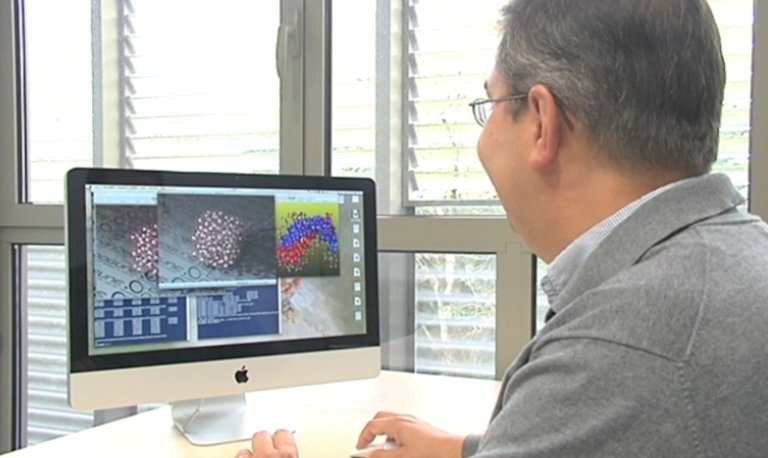The virtual reality of atoms

There's little in the movies that looks like it. Even less so since digital resources made it possible to create virtual worlds. in “Life of Pi”, for example, the tiger is virtual, it is made of computers, and also the flying fish of this scene, the sea and the sky itself.
Digital elements in cinema have been developed as a means of creating what cannot be done in reality. And it is an art to create virtual worlds that the viewer will take for granted. One of the keys to this art is physics, that is, in this virtual world it is necessary to comply with the basic physical laws that we consider natural in the real world.
Not only for entertainment, but virtual simulations are also used in the industry, among other things, to test this situation virtually on the computer instead of a real test or experiment.
EMILIO ARTACHO; Ikerbasque researcher, CIC nanoGUNE: Some simulations are performed directly on a macroscopic scale. The most popular ones today are those that use fluid dynamics, for example, in the aerospace and naval industries, and even filmmakers use it to simulate rough sea without actually having it. All of this is done through fluid dynamics. They are macroscopic simulations in which equations are used that describe the dynamics of water or air, taking into account viscosity, density and so on.
At CIC nanoGUNE they have started offering a service based on simulations. The innovation is that simulations are not macroscopic, but atomic. It is called Simune and goes to the core of the macroscopic properties of materials: the interaction between atoms. And for this, they are based on the quantum laws of physics.
EMILIO ARTACHO; Ikerbasque researcher, CIC nanoGUNE: Two questions come into play: the macroscopic properties of matter, that is, those we see in our world, and properties related to the movement of atoms, or to the movement of nuclei and electrons, on a nanometric scale, or below the nanometric, such as hardness, how this material behaves in response to changes in temperature or pressure... The movement of atoms and the attraction between them directly affects the properties we see in our world. We investigate this movement with our virtual microscope, computer simulation methods. In this way, we anticipate the property that interests us. How long a battery will last, how strong it will be, how light it will be... all this depends on what happens with atoms on a sub-nanometric scale.
SOLA ESTER; Simune: In general, not all of the material is analyzed in these methods. It's logical, if we have a lot of material, we can't investigate all of its atoms. So we divide it into cells, cells that repeat themselves one after another in space. And the conditions within the cell are the same as the macroscopic conditions. We apply some special conditions around the cell to simulate the presence of other adjacent cells. This allows us to study it as if it were an infinite system using a finite number of atoms.
Atomic simulation tools have long been used in research, and the aim is to extend the possibilities of this resource to industry as well.
SOLA ESTER; Simune: Now we want to go a step further and offer it to the companies saying: “Look, this tool can be useful for you, it will help you save money and time.” In fact, until now, it was necessary to carry out an experiment to investigate the properties of a matter, both intentionally and unintentionally. But it takes a lot of time if you do the first calculations, because it can help you put limits on your lab work.
One of the most widely used computational software in atomic simulations in research is the so-called SIESTA. Some of the developers of this tool make up the panel of experts of Simune, such as Emilio Artacho, to whom the responsibility is to decide how to proceed to a certain simulation, knowledge being the contribution of these experts. And this is the core of atomic simulation; besides that, they only need the right software and computing capacity, that is, computers.
SOLA ESTER; Simune: Here at nanoGUNE, Simune has its own computers, but we also use those from outside, such as those from the University of the Basque Country. And if necessary, we can also use clusters at national and international level, depending on the calculation we have to make, we can be in need of a supercomputer, the Mare Nostrum of Barcelona, or something similar.
The computing capacity of computer clusters is constantly increasing, which makes it possible to carry out increasingly accurate simulations.
EMILIO ARTACHO; Ikerbasque researcher, CIC nanoGUNE: With simulations you anticipate a lot of experiments. And if the simulation is good, you have a much better understanding of what happens, because it allows you to know in detail what happens. It is difficult to get to this detail in the experiments. It is good that experiments and simulation go on the same yoke, because one values the other; but with simulations we learn much more.
Buletina
Bidali zure helbide elektronikoa eta jaso asteroko buletina zure sarrera-ontzian











